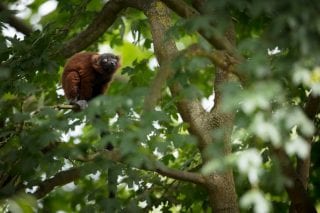Fun Facts
Litters of Lemurs
Red ruffed lemurs are one of the few lemurs that give birth to multiple young. They take care of their young as a group. Taking care of infants can take a lot of energy and sharing the responsibility is one of the ways these lemurs can help manage this.
Noisy neighbours
In Dublin Zoo the red ruffed lemurs are far more vocal than their ring-tailed lemur neighbours. Red ruffed lemurs use alarm calls to alert others that there is a predator nearby and gather a ‘mob’ or group to back each other up against the threat. This can deter predators like fossa who may give up on a hunt if surrounded by loud lemurs in the trees.
They can also use vocalisations to find mates and long, booming calls to communicate over large distances.
Pollinators
Red ruffed lemurs can lick the nectar from flowers and get pollen on their faces in the process. When lemurs stick their faces into the next flower to feed on, they pass on pollen from previous flowers they visited, helping plants make seeds to create more plants. This makes red ruffed lemurs important pollinators in their habitat, just like bees in Ireland.
Toothcomb
Red ruffed lemurs, like many other lemurs, use the teeth on their bottom jaw like a comb to clean both their fur and the fur of others in their troop. This is very important for keeping up friendships and family bonds.



